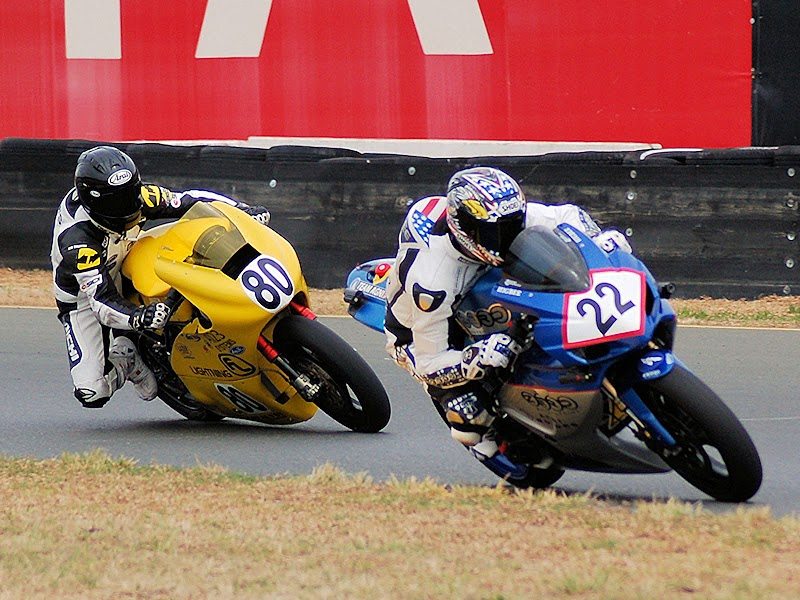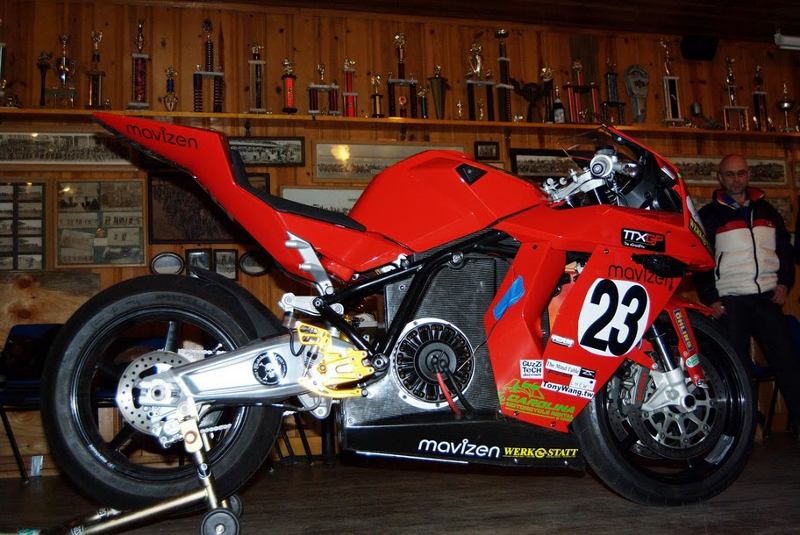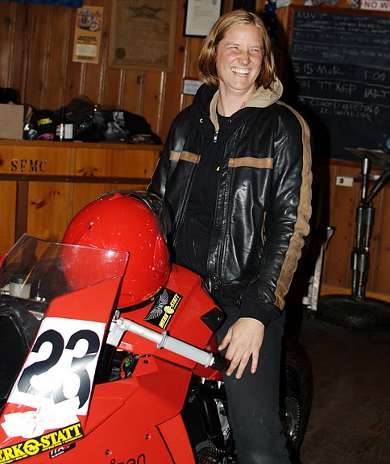
Shawn Higbee (22) passes Michael Barnes (80), soon to be passed back thanks to the Lightning’s monster motor – Shawn went on to win
After picking up my press credentials at the Infineon Raceway front gate, I was walking back to my motorcycle when a dumpy-looking, middle-aged woman emerged from a battered Prius and looked at me, looked at my filthy, noisy-looking Ducati and said, loudly, “oh, I forgot my earplugs.” Then she fixed her eyes back on me and said, “Well, I guess I don’t need them; I’m here for the quiet race,” and got back in her car, which was probably partially powered by waste heat generated by her hyperactive smugness gland.
An interesting sideshow to the Infineon round of the AMA Pro Racing series was the historical first round of the U.S. TTXGP, a zero-emissions roadrace based on the inaugural TTXGP held at the Isle of Man last year. Not surprisingly, the tech-heavy and green-friendly San Francisco Bay Area had no shortage of willing participants, with teams from Zero and Oakland’s Electric Motorsport as well as local racer and moto-shop owner Jennifer Bromme. The bikes were an eclectic bunch, based on everything from Bromme’s KTM RC8/Mavizen to a vintage Norton chassis. I had a chance to look over Bromme’s machine at a pre-race fundraising event (she’s renting the bike from Mavizen, a company started by Azhar Hussain, originator of the TTXGP series) and noted a tiny tablet PC mounted where the instrument panel should go. A tiny sticker next to the screen cheerily read “Windows XP!” “Uh-oh,” I thought: sounds like a recipe for disaster.
After practice and qualifying on Saturday, the TTXGP event was the first race scheduled for Sunday. Ten motorcycles made it to the grid, with AMA fast guy Shawn Higbee on the Agni/Zero machine in the front row next to fellow AMA pilot Michael Barnes on the bright-yellow Lightning Motorcycles Lightning Superbike. Barnes’ racer went 166 mph at Bonneville last year and is equipped with a liquid-cooled 104-kilowatt motor (allegedly) from a Saturn EV-1. The electric bikes’ laptimes aren’t very impressive compared to conventional racebikes-Higbee’s fastest qualifying lap at Infineon would put him solidly mid-pack in a club-level middleweight Twins race-but it’s impressive enough to get the attention of the green-minded crowd.
Soon I was sitting in the grandstands overlooking the start/finish, where I usually put in earplugs to protect my eardrums from the deafening roar of dozens of high-performance engines. Not this time; in fact, I even shushed the fans sitting around me: “Quiet! I can’t hear the bikes!” Sure enough, as the Lightning purred into place on the grid, I could hear a high-pitched whistling from its exotic motor. That wasn’t enough for one race fan behind me. He thought it was cool, but still “lacking” something. His buddy joked that you had to attune your ear for the new aural experience…”some of them sound like a blender, some like a drill, some are more Cuisinarty…” When the starter waved the flag, watching the bikes whisper past the stands was ironically anti-climactic, although Barnes did rocket out to an immediate 20-bike-length lead over the field.

Mavizen’s bike is the first one rented to a customer
It didn’t last. The banana-like bike had cornering-clearance issues, and Higbee’s GSX-R600-based machine did not. For the first several laps of the 11-lap race, Higbee kept running up the inside of Barnes’ bike going into turns and losing ground on the straights as the Bonneville-tuned machine charged off the apexes. But Higbee realized it would be an endurance race (if a very short one) and carefully managed his batteries. The strategy paid off when Barnes’ power management safety override tripped on the ninth lap, costing him 45 seconds while he restarted. After the restart, the Lightning was noticeably slower, while Higbee kept his laptimes consistent, finishing over 20 seconds in front of Barnes. The mildly interested crowd actually applauded politely. “Huzzah!” I exclaimed. They didn’t have enough juice for a victory lap, much less celebratory wheelies and burnouts.
 |
|
San Franciscan Jenn Bromme on her KTM RC8-based
Mavizen electric superbike |
The rest of the field was much further back, with much slower laptimes. Although Barnes and Higbee’s machines showed impressive acceleration and the racers put on a great show for a surprisingly large crowd, watching the slower bikes was like watching yacht racing (or pornography for tree sloths) while high on LSD. But the race went through to the end, and only two bikes didn’t finish the 25-mile race, one of them completing nine laps before rolling to a stop. Electric Motorsport’s Michael Hannas took third, and even though Bromme’s computer crashed on the first lap (thanks, Windows XP!), she got it re-booted in time to finish fourth.
The first zero-emissions (yes, we know electric power often comes from dirty sources, although most of California’s electricity comes from cleaner-burning natural gas or renewables) motorcycle race in the USA wasn’t the most exciting race I’ve seen, but it was entertaining, interesting-and a taste of the future. Like it or not, electric vehicles are coming: it’s just a matter of how soon. Stock up on 900-amp fuses.
Vist the TTXGP website for more information about upcoming USA events.






Michael, I apologize for the error! I’m learning a whole new thing here with e-bike manufacturers and teams.
I have ridden an electric moto, the Zero in fact. I’m always game for a ride, however!
Gabe,
Thanks for the coverage on the TTXGP opener at Infineon. Maybe you should try riding one sometime. By the way, I took third on the ELECTRICRACEBIKES.COM entry, NOT Electric Motorsports as you printed…just wanted to make sure the right guy got the credit, Matt at ElectricRaceBikes.com is pretty much a one man show and I know he would appreciate the credit. Thanks again for the coverage, I think you will see as these bikes develop that the speeds will increase dramatically, remember, this is only the beginning!